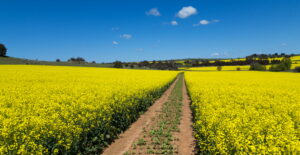It is hard enough forecasting commodity production for the coming season, let alone any further. Regardless, The Australian Bureau of Agricultural and Resource Economics and Sciences (ABARES) do like to have a stab at forecasting crop production for the coming five years, and they are worth a look.
In their
Agricultural commodities and trade data tables, released in March, ABARES
forecast crop area, yields and therefore production for major Australian
commodities. ABARES also look at prices,
which are impossible to predict, and in these forecasts usually end up very
close to the current value.
ABARES are
forecasting Australian wheat production to lift over the coming two years
(figure 1), as improved seasons encourage higher plantings and see stronger
yields. The following two years are
expected to see weaker production, before another lift.
The shifts
in production are due to both changes in plantings and yields. Forecast yields range from 2.125 in 2026-27
to 2.557 in 2028-29. The average yield
in the year just gone was 2.09t/ha, with ABARES expecting better years to come.
For canola,
the trends in production are similar, with drivers being the season. Two years of improvement are expected to give
way to lower production before hitting a seven-year high in 2028-29. Planted area bounces around a lot more for canola
forecasts, which is what happens historically.
When
relative prices favour canola, more goes in, and vice versa when relative
canola prices are weaker.
Figure 3
shows wheat and canola annual average prices for the last two years. For wheat ABARES quote APW free on board
Adelaide, and canola is delivered to Melbourne.
Long-term price forecasts are usually relatively flat, and actual prices
never end up that way. As we know, there
are plenty of left-field events, which can not be predicted, which move prices
up or down.
What does it mean?
The production forecasts for the coming year show that ABARES expects better yields with a more normal season. Weaker prices also look likely in the coming year, based on where values are at now, and how forward curves look.
We know, however, that international influences have much stronger impacts on price than production here in most years. Those price movements which are governed by international markets will in part drive what crops are put in the ground.
Have any questions or comments?
Key Points
- ABARES are forecasting stronger wheat and canola production in the coming year.
- Past 2024-25 forecasting is almost impossible but ABARES expects weaker production.
- Prices look like they might be lower in the coming year, but will be influenced more by international factors.
Click on figure to expand
Click on figure to expand
Click on figure to expand
Data sources: ABARES, Mecardo















